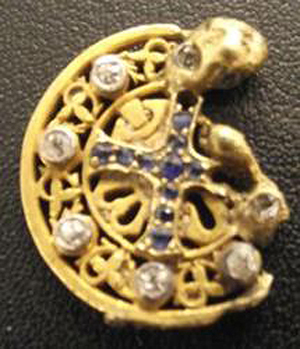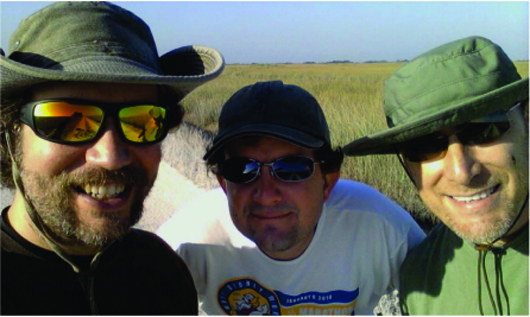
MIAMI (PRWeb) – Walker Metalsmiths, a western New York State jewelry firm, is using its resources and expertise to try to solve a mystery.
The story of Mark Rubenstein’s remarkable discovery of a partially melted gold cross medallion in the Everglades brings together the 2013 Python Challenge snake hunt, two tragic airline crashes, and a small but mysterious treasure. The jewelry looks like a Celtic cross pendant, but consultation with Celtic jewelry expert Stephen Walker tends to point in a different direction.
While hunting the Everglades in February for invasive Burmese pythons, Mark Rubinstein spotted a jeweled gold cross set with antique rose-cut diamonds and sapphires. The condition of the piece and the location of the find strongly suggest that the antique medallion came to rest in the swamp as the result of a fatal plane crash. In the late afternoon Rubinstein caught a glimpse of a bright, out-of-place, bit of sparkle. With fellow snake hunters Joseph Post and Gregg Jobes, he stopped and pawed through the grass and dirt until they unearthed a jeweled gold pendant about the size of a penny.
The location of the find turns out to be about 300 yards from the May 11, 1996 crash site of ValuJet Flight 592 and directly in the debris field of crashed Eastern Airlines Flight 401 that went down in 1972. The ValuJet crash killed all 110 passengers and crew. Seventy five people survived the Eastern crash, but 101 perished.
Realizing that the treasure they had found in the swamp was almost certainly the property of one of the deceased, the friends decided to try to try to identify the owner with the goal of returning it to a family member or heir. Rubinstein says, “I would like, strongly, to get it back to the rightful heirs. It would be some really good karma for all involved, or to put it simply, the right thing to do.”
Jeweler Bob Moorman of Carroll’s Jewelers in Coral Springs, FL identified the materials as high-karat gold, 18K or better, with rose-cut diamonds and sapphires. “Rose cut” is an antique style that was predominantly used from the 17th to the 19th century, which would make the piece 100 to 400 years old.
When a picture of the pendant and its story came to light on the Orchid internet jeweler’s forum, Stephen Walker became involved. Since Walker recently wrote a book on the Celtic jewelry of the 19th and 20th centuries, his initial involvement was to comment on how the pendant may or may not be a “Celtic” cross. Although it looks like a Celtic cross is probably part of an Eastern or Greek Orthodox tradition. The cross in a circle as a cultural icon of the Irish, Scots and other Celts was a familiar form for monumental sculpture, carved in stone, in medieval times. In the past 150 years is has come to be used as a symbol in jewelry. This particular piece, however, differs in style and choice of materials from what we generally see in antique Celtic crosses. Precious gemstones, such as diamonds and sapphires are rarely used in Celtic jewelry until much more recently. The few older pieces made in gold were usually 9 carat, while this piece is a higher carat. The stones used in 19th century Celtic jewelry were generally semiprecious materials like agates, amethyst, citrine and bloodstone.
Walker put Rubinstein’s photo and story on Walker Metalsmiths’ Facebook page, which quickly went viral. He then issued a news release, which brought the story to an even wider audience.
When an alert California man saw the story online about the pendant, he recognized it as nearly identical to a piece in his own collection. He sent Walker a picture with all four of the letter/symbols between the arms of the cross clearly visible. The letters appear to be Greek or Slavonic. This shows that the piece is part of a traditional combination of symbols an not one-of-a-kind. The California piece was purchased over 40 years ago from an antique dealer and nothing specific is known about its origin.
The overall design is very much like a Saint Benedict’s medal, but the characters are different. Scholars who have looked at the design tend to think the letters are more likely to be Greek than Slavonic but several characters are unconventional. They may be Epsilon, Pi, Omega, Phi. The Greek “M”, mu, looks like a lower case omega when flipped upside down.
Walker has fielded several calls and emails from the public, but a positive identification remains elusive. Walker says, “We will follow up on any plausible leads, but our best hope is showing the picture and telling the story far and wide until someone with a direct personal memory sees it”
Walker Metalsmiths is a family-run, craftsman-based, Celtic jewelry company with locations in Andover, NY and Fairport, NY. Contact information is available online at www.walkermetalsmiths.com.
# # #
ADDITIONAL IMAGE OF NOTE


